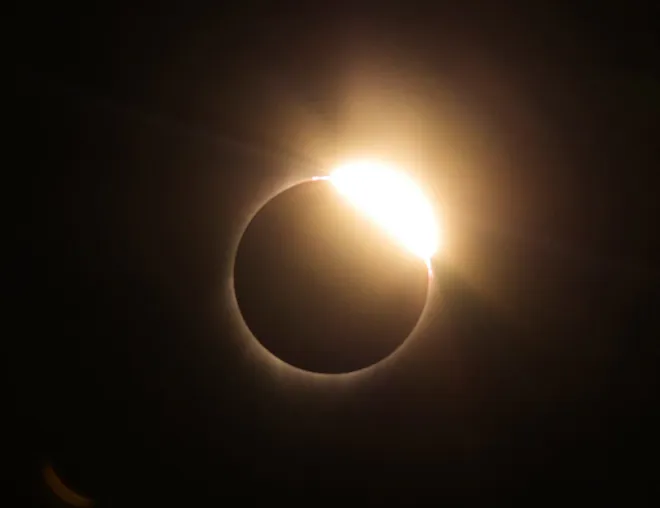'A cosmic masterpiece': Why spectacular sights of solar eclipses never fail to dazzle
It's not often that solar eclipses race across our skies, the moon blotting out the sun to usher in captivating rings of fire like in October or complete and utter darkness such as what will transpire Monday.
Though it's only been a matter of six months since the annular solar eclipse, it's more common for years and years to pass between these spectacular celestial events.
And when they do occur, they're undeniably beautiful.
Because the events are so rare and so mystifying, astronomers say it's no surprise that the years have done little to dampen the awe-inspiring power eclipses hold over us. Whenever one is set to occur, the promise of catching a glimpse of such a dazzling spectacle – whether it be a complete eclipse or only a partial one – always manages to capture the public's attention.
"I think humans have a deep connection with the night sky," Cameron Hummels, director of astrophysics outreach at the California Institute of Technology, previously told USA TODAY. "Astronomical events like eclipses, meteor showers, and the northern lights are a way in which they can experience it first hand."
Your guide to the eclipse:What to know before totality hits Monday
Total solar eclipse is chance for millions to see totality, corona
The phenomenon of an eclipse is rare enough as it is, but the upcoming astral display will quite literally be a once-in-a-lifetime spectacle to behold. Compared to the last total solar eclipse in 2017, this year's even will produce a brighter corona around the sun, a larger moon and a longer totality.
Millions of Americans have now long been eagerly awaiting what will be their only chance until 2044 to witness totality, whereby the moon will completely block the sun's disc, ushering in uncharacteristic darkness.

Americans across the country will flock Monday to eclipse watch parties at libraries, national parks and other venues to catch a glimpse of the phenomenon, which will pass over portions of Mexico, the United States and Canada. Here in the U.S., 13 states fall directly in the path of totality, which will offer the most captivating views.
The process and reasons for an eclipse have long been understood by scientists, but it hasn't diminished the excitement that bubbles up anytime an eclipse approaches. Many astronomers, like Christopher Sirola from the University of Southern Mississippi, even view eclipses as an opportunity to harness public captivation to educate about the science behind the phenomenon.
"Solar eclipses are very predictable, but their regularities are not obvious," Sirola said. "Such events are awesome, especially total solar eclipses."

Eclipses offer scientists a chance to study sun
We may think of astronomers and astrophysicists as studious and objective observers of the skies, but solar eclipses are equally exciting for them.
And while much of that eager anticipation is purely for the celestial light show that will be on display, there's an academic reason as well.

Describing eclipses as "a cosmic masterpiece," Elsayed Talaat of the National Oceanic and Atmospheric Administration told USA TODAY that the celestial events afford scientists an opportunity to study the sun much closer than normal.
Total solar eclipses in particular, such as the one that will overtake a large swath of the country in April, allow for scientists to test and improve human understanding of the laws of physics, primarily those of the sun. Veiled by the massive star's bright light, the sun's corona becomes visible during a total eclipse, allowing astronomers to conduct observations normally impossible, said Talaat, director of NOAA's Office of Space Weather Observations.
At NASA, for instance, a team of engineering physicists plan to launch three sounding rockets Monday toward the sun to study how a loss of sunlight alters Earth's atmosphere.
The corona to this day remains shrouded in mystery, as Talaat said scientists are unsure of just why the outermost layer is able to reach a temperature of 1.8 million degrees Fahrenheit compared to the 10,000 degrees measured on the surface of the sun itself.
Scientists at NOAA use a telescopic device called a coronagraph to replicate the effects of an eclipse by blocking out the direct light from the sun in order to measure a corona year-round without relying on the moon's orbit.
NOAA’s newest geostationary satellite will carry a coronagraph onboard when it launches for deep space next year, while a 2025 mission will also bring another device roughly 1 million miles away from earth to allow for unobstructed observations of the corona.
However, Talaat admits there's nothing like seeing an eclipse for yourself.
"It's very different to be able to see it with your own eyes from the ground; that's a very powerful experience for me," Talaat said. "It reminds me — it reminds us — that the sun is powerful in ways we don't fully understand or quite appreciate."
Eric Lagatta covers breaking and trending news for USA TODAY. Reach him at elagatta@gannett.com
Disclaimer: The copyright of this article belongs to the original author. Reposting this article is solely for the purpose of information dissemination and does not constitute any investment advice. If there is any infringement, please contact us immediately. We will make corrections or deletions as necessary. Thank you.




